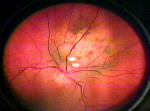Ophthalmic Videography Service
Videographer: Randall E. Verdick, BA
Comments or questions to: randall-verdick@uiowa.edu
The ophthalmic video services at Iowa are among the best in the country.
Video is viewed and recorded daily from numerous sources. Many surgical
microscopes and clinical slitlamps are equipped with color video
cameras, color monitors, and S-VHS VCRs. A broadcast quality camcorder
is located in the video office for patient full face and close up external
video and also for video production work.
The Braley Auditorium is equipped with a closed circuit video system
allowing transparencies and opaque materials to be displayed, ophthalmic
pathology microscope slides to be seen, videotapes shown, and computer
program presentations utilized, all through a multisync video projector
with a 10' diagonal screen. This CCTV system is used during daily morning
conference, weekly fluourescein and pathology conferences, and for monthly
clinical conferences.
One of the two video indirect portable systems has a video printer
allowing the Pediatric service to take photographs of infants and children
without using a hand-held fundus camera. The Retina service also uses
a video indirect to clinically document pathology and teach. The system
may also be taken into the OR and used during surgery.

Video Indirect image of Intraocular Tumor
A unique instrument we utilize is the Iowa Infrared Pupilometer that
allows a clinician to view a patient's eyes in the dark through the
use of infrared LEDs and an infrared sensitive video camera.

Infrared Videography Instrument
The Pediatric department uses video as a children's fixation device.
Eight exam rooms are equipped with color monitors that are fed cartoons
via a video/audio distribution amplifier. A footswitch instantly turns
the cartoons on and off. This cartoon fixation system has proven very
helpful in maintaining a child's fixation during examination.
A post production facility allows videotape editing through an Amiga,
Video Toaster and Amilink Edit Control. Any combination of videotape,
slides, photographs, audio, etc. can be included into the production.
Video programs have been produced for the AAO COVE program and the AAO
Annual Video Program. Numerous in-house programs have also been produced
for resident, fellow, nurse, and technician education.
|